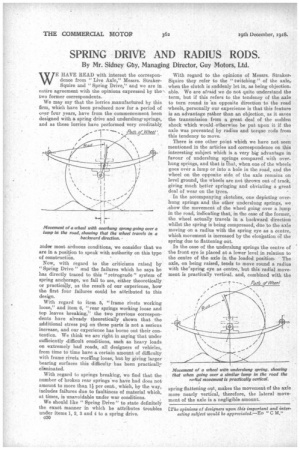SPRING DRIVE AND RADIUS RODS.
Page 10

If you've noticed an error in this article please click here to report it so we can fix it.
By Mr. Sidney Gtiy, Managing Director, Guy Motors, Ltd.
WE HAVE READ with interest the correspondence from "Live Axle," Messrs. StrakerSquire and "Spring Drive," and we are in entire agreement with the opinions expressed by the two former correspondents.
We may say that the lorries manufactured by this firm, which have been produced now for a period of ov,er four years, have from the commencement been designed with a spring drive and unclerslung, springs, and as these lorries have performed very creditably ander most arduous conditions, we consider that we are in a position to speak with authority on this type of construction.
Now, with regard to the criticisms raised by "Spring Drive" and the failures which he says he has directly traced to this " retrograde " system of spring anchorage, we fail to see, either theoretically or practically, as the result of our experience, how the first four failures could be attributed to this design.
With regard to item 5, " frame rivets working loose," and item 6, "rear springs working loose and top leaves breaking,'" the two previous correspondents have already theoretically shown that the additional stress put on these parts is not a serious increase, and our experience has borne out their contention. We think we are right in saying that under sufficiently difficult conditions, such as heavy loads on extremely bad roads, all designers of vehicles, from time to time have a certain amount of difficulty with frame rivets worring loose, but by giving larger bearing surfaces this difficulty has been practically eliminated.
With regard to springs breaking, we find that the number of broken rear springs we have had does not amount to more than 1 per cent., which, by the way, includes failures due to faultiness of material which, at times, is unavoidable under war conditions.
We should like " Spring Drive" to state definitely the exact manner in which he attributes troubles under items 1, 2, 3 and 4 to a spring drive. 030 With regard to the opinions of Messrs. StrakerSquire they refer to the " twitching " of the axle, when the clutch is suddenly let in, as being objectionable. We are afraid we do not quite understand the term, but if this refers to the tendency of the axle to turn round in an opposite direction to the road wheels, personally our experience is that this feature is an. advantage rather than an objection, as it saves the transmission from a great deal of the sudden shock which would otherwise be put upon it if the axle was prevented by radius and torque rods from this tendency to move.
There is one other point which we have not seen mentioned in the articles and correspondence on this interesting subject which is a very big advantage in favour of underslung springs compared with overhung springs, and that is that, when one of the wheels goes over a lump or into a hole in the road, and the wheel on the opposite side of the axle remains on level grounds the wheels are not thrown out of track, giving much better springing and obviating a great deal of wear on the tyres.
In the accompanying sketches, one depicting overhung springs and the other underslung springs, we ,show the movement of the wheel going over a lump in the road, indicating that, in the case of the former, the wheel actually travels in a backward direction whilst the spring is being compressed, due to the axle moving on a radius with the spring eye as a centre, which movement is increased by the elongation ol the spring due to flattening out.
In the case of the underslung springs the centre of the front eye is placed at a lower level in relation to the centre of the axle in the loaded position. The axle, on being raised, tends to move round a radius with thespring eye as centre, but this radial movement is practically vertical, and, combined with the spring flattening out, makes the movement of the axle more nearly vertical, therefore, the lateral movement of the axle is a negligible amount.






















